
11 minute read
BlueScope Celebrates 50 Years of Basic Oxygen Steelmaking
BlueScope's Steelworks at Port Kembla, in the Illawarra region, is the largest steel production facility in Australia. With an annual production capacity of over three million tonnes of crude steel, it manufactures slab, hot rolled coil and plate products. The Basic Oxygen Steelmaking (BOS) facility plays a critical role—not only for BlueScope's Steelworks— but as a crucial piece of Australia's manufacturing infrastructure. On 13 July 2022, the BOS celebrated its 50th anniversary.
Advertisement
In 1972, BlueScope invested $45 million into building the BOS at its 760 hectare Port Kembla Steelworks. Over the last 50 years, the BOS has produced over 180 million tonnes of steel, converting liquid iron into steel.
These 180 million tonnes encompass flat steel products, including slab, hot rolled coil, cold rolled coil, plate and valueadded metallic coated and painted steel solutions. BlueScope is firmly focused on higher value branded products for the building and construction industry.
According to Kamini Wijekulasuriya (BOS Furnace Operations Manager, BlueScope), "The BOS at Port Kembla produces all of BlueScope's steel— approximately 3.3 million tonnes per annum. We manufacture over 100 grades of steel. Over 60% of that steel is our premium COLORBOND® steel brand that is used across commercial, industrial, residential, fencing and roofing applications. We also make steel for a variety of other applications, like wind towers. Anywhere there is steel, you can find BlueScope." "The BOS plays a critical role in BlueScope's steelmaking process. Every piece of steel that BlueScope manufactures in Australia has to go through the BOS. If we stop, BlueScope stops producing steel," said Kamini.
When the BOS commenced operation in 1972, there were two furnaces, with a capacity of around 4.8 million tonnes of steel per annum. Today, BlueScope operates one furnace at a time, with the other on standby or under maintenance.
Before the BOS was built, BlueScope’s Port Kembla Steelworks produced steel using the open hearth process. The open hearth process produced the same amount of steel in eight hours as the BOS does now in around 25 minutes. The Number 2 Open Hearth started operation at Port Kembla in 1956 and ended in 1982—there were about 10 years where the BOS and Number 2 Open Hearth ran in parallel.
CELEBRATING BLUESCOPE'S STEELMAKERS
Kamini clearly loves her job. "Working at the BOS is interesting, challenging and exciting. No two days are the same," said Kamini. "My role is the BOS Operations Manager. I have accountability for 60 people, their safety,
“The BOS plays a critical role in BlueScope's steelmaking process. Every piece of steel that BlueScope manufactures has to go through the BOS. If we stop, BlueScope stops making steel."
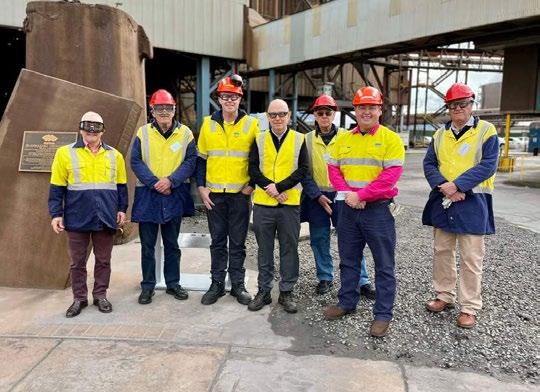
BlueScope team members accompany retirees on their visit to the BOS for the 50th anniversary celebrations. BlueScope leaders past and present at the 50th anniversary celebrations.
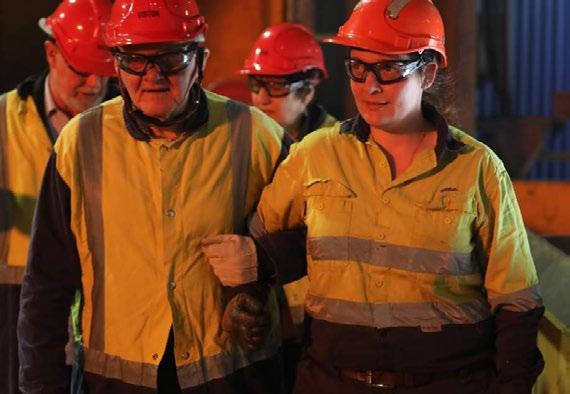
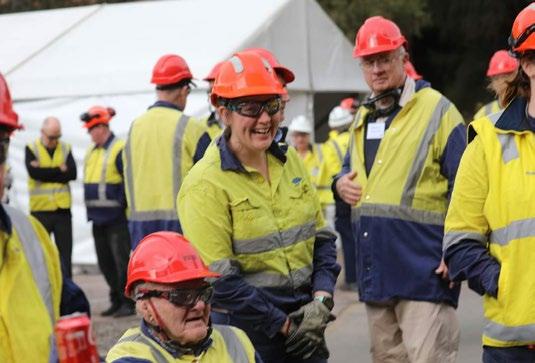
BlueScope retirees, some of whom blew the first heat at BlueScopes BOS. 50th anniversary celebrations.
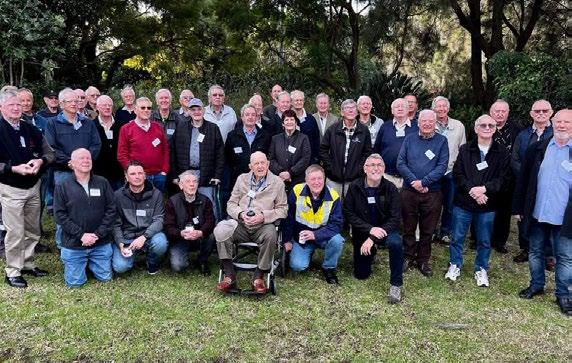
the BOS operations and the quality of the steel. Our operations include the BOS furnace as well as several auxiliary plants—a water treatment plant, a lime kiln and a desulphurising plant. This makes my job even more interesting; all the plants need to work in unison so that the entire system functions."
DIVERSITY AND INCLUSION
BlueScope has a strong focus on inclusion and diversity; its goal is an organisation where all people— regardless of how they identify—feel valued and included at work.
"Diversity and inclusion are a big part of our business. The BOS Operations team is comprised of 15% female employees. We've got the biggest cranes in the southern hemisphere—450 tonne cranes that charge the molten metal. Males and females drive those cranes. We have females working in the control room who blow the heat, making them responsible for the quality of steel and the addition of the correct alloys.”
“Our diversity isn't limited to gender— our workforce is diverse in terms of skill, cultures and ages and a range of other factors. All of this leads to diversity of thought—we all learn from one another. All our people take a lot of pride in their work, and in the steel that they are producing. It is fantastic to be a part of such a diverse, inclusive, enthusiastic team," said Kamini.
A CULTURE OF SAFETY
Safe and inclusive workplaces are integral to the way BlueScope does business—for their people, those who work throughout their supply chains and the communities in which the company operates.
"The BOS process is spectacular—you certainly never get tired of watching it. But, this spectacular sight involves working with molten iron and steel, so there are process related risks present in the plant. That's why safety is always our number one priority. Safety is considered first in everything we do. The first agenda item in our morning meeting is safety—not tonnes or quality," said Kamini.
"We have very stringent procedures that are categorised in terms of their critical nature. We provide extensive training to all our team members, and empower our people so that they understand the consequences if things go wrong. If procedures are categorised as 'critical', employees have to be accredited to the procedure every 12 months. We focus heavily on near miss reporting and follow up all incidents—it's how we improve." "Safety is part of our DNA. It's how we do business."
"As a result, our Operations team has been without Lost Time Injury (LTI) for 11 years. And our Maintenance team has been 18 years LTI free," said Kamini.
AUTOMATION AND TECHNOLOGY
While the steelmaking principles remain the same, the BOS has undergone significant changes, particularly over the last 20 years.
"For our celebration on 13 July, we invited about 50 people who had worked at the BOS previously—some of our guests were actually working at the BOS for its very first heat. We offered them a tour of the place, and they all had the same feedback. While the furnace is the same, the technology has changed enormously. There is a lot more automation," said Kamini.
The lime kiln and water treatment plant are both automated, eliminating the need for operators. The lime kiln is filled using front end loaders. However, the rest of the operation has sensors that trigger alarms and alerts as required. BlueScope has also automated the process for taking turndown samples. Previously, the
To watch the BOS vessel in action is quite striking; there’s a loud roar as the mix of scrap steel and molten iron is heated up with oxygen, then flames start to climb out of the top of the vessel, changing from orange to a white so bright it forces you to turn your eyes away. It’s also really hot— throwing more than 1,500°C.
The BOS is the point at which all the ingredients are combined to make steel. The molten iron comes via rail from the blast furnace in torpedo ladles. When they arrive at the BOS, the torpedo ladle is tipped on its side and about 250 tonnes of molten iron are poured into a hot metal pot.
While that’s happening, a huge hook lifts up a massive skip full of the other main ingredient that goes into the BOS—approximately 70 tonnes of scrap steel. Part of the advantage of using scrap steel is it means the process calls for fewer raw materials - though BlueScope is pretty picky about what sort of scrap they use.
A siren sounds, which is the signal for everyone to stand well clear of the BOS vessel or enter the perspex and metal-grilled control room opposite, because of the small chance of ingredients flying out of the vessel.
The skip of scrap steel goes in first, followed by the molten iron, which starts eating the scrap and creating flames and heat. Then an oxygen lance descends, stopping just above the molten mixture. It shoots oxygen into the vessel at two-and-a-halftimes the speed of sound for about 16 minutes. And that’s when all the sparks and flames fly. What’s happening in there is the oxygen is reacting with the carbon in the vessel, which creates the heat. At the end of the 16 minutes, the lance is removed and the vessel is tipped backwards where the 275 tonnes of molten steel runs into a ladle via a hole in the side.
The vessel then tips forward to remove the slag: a byproduct of the process that forms on top of the steel. Then more scrap steel and molten iron goes in, and the process starts all over again.
This article first appeared in the Illawarra Mercury: illawarramercury.com.au
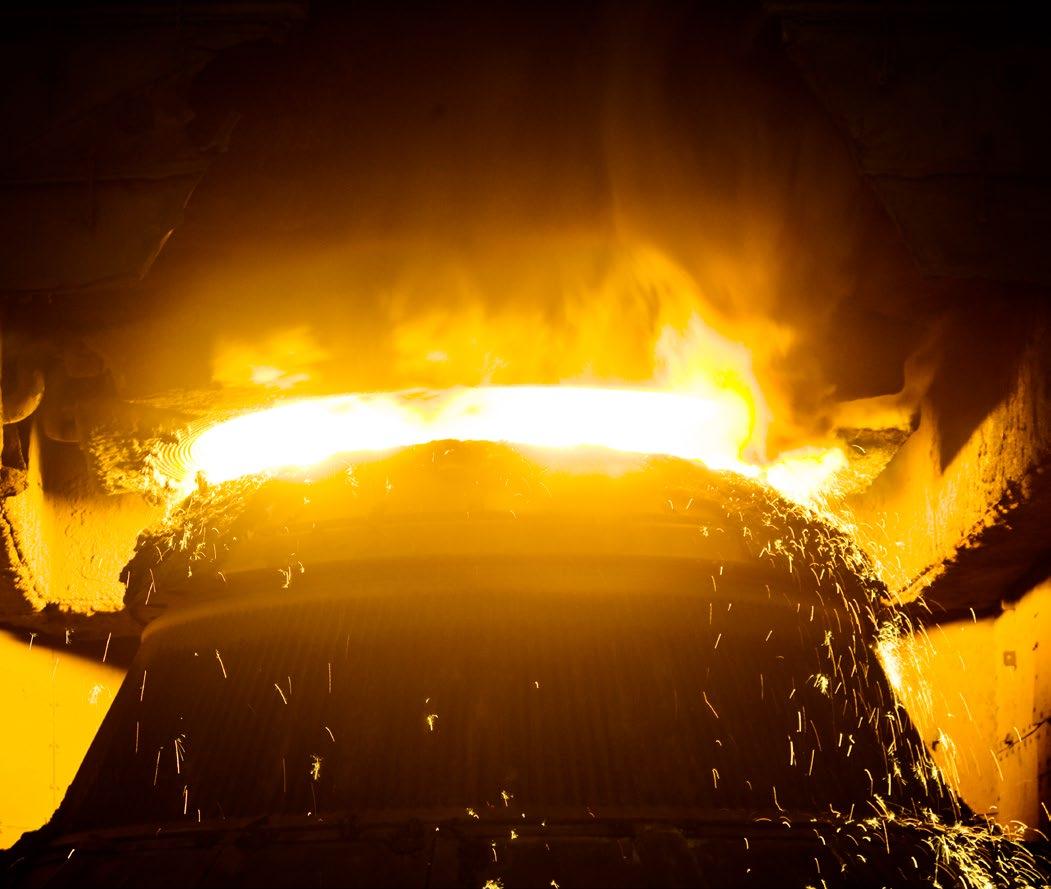
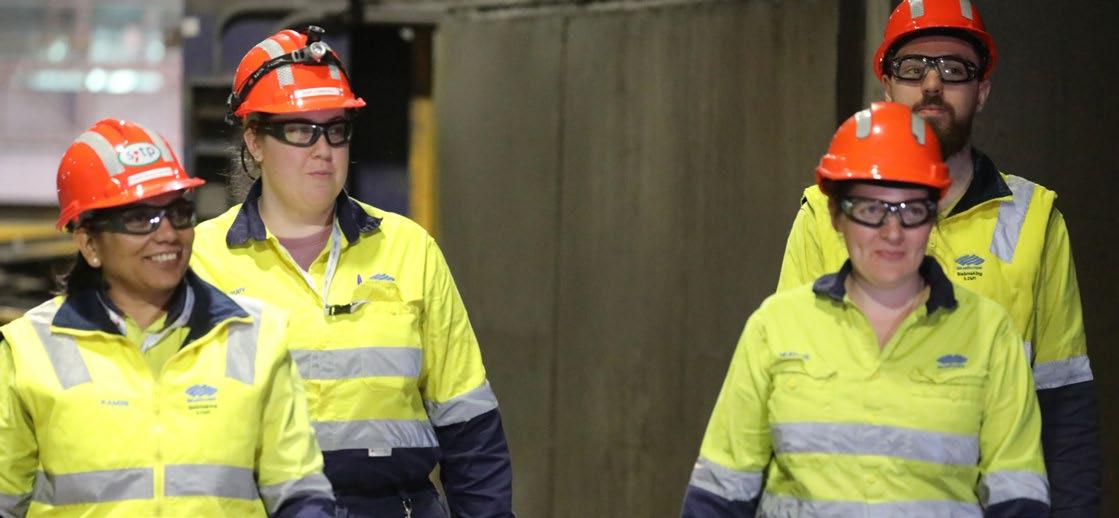
furnace was manually tilted by an operator who then inserted a probe to take a sample. Today, a sub-lance is driven into the furnace via pushbutton in the control room, takes the turndown sample, and transfers it to an operator who prepares the sample and sends it to the lab via a Lamson pneumatic tube.
"We also have machine learning and a lot of digital technology. For instance, one of our machine learning systems can confirm when it is the right time to tap the heat. Prior to this, the person in the control room had to have years of knowledge and experience so that they could identify when the steel was at the correct quality for tapping. Now, we have a model that analyses the key parameters and—quite literally—gives you the green light."
"We’re looking at opportunities to automate all the time. Like any industry, we have to be fit for the future," said Kamini.
THE FUTURE OF THE STEELWORKS AND THE BOS
"For the BOS, our future is focused on sustainability, remaining an efficient and cost competitive operation. This requires having the right people, the right focus from a technology point of view and the right procedures in place," said Kamini.
"We are also focused on greenhouse gas intensity reduction. To ensure a sustainable future, we have to be efficient, and the BOS plays a key role in that. By using a higher proportion of recycled steel scrap, we can reduce the carbon intensity of our steel. The hot metal charged into the furnace has a carbon content of 4.5%, whereas recycled steel scrap has carbon content of about 0.05%." "Currently, we charge approximately 75 tonnes of recycled scrap per heat. We are looking to increase this to 85 to 95 tonnes per heat, by investing in the equipment and technology necessary to transport and melt the scrap. Not only will this reduce our greenhouse gas intensity, it will also enable us to make more tonnes of steel," said Kamini.
In the 2021 financial year, 46% of BlueScope’s raw steel production originated from recovered and recycled scrap steel, with 98% material efficiency achieved across its three steelmaking facilities. Where practical, BlueScope uses co-products and by-products, from both its own operations and other sources, as substitutes for virgin raw materials. Besides the commercial benefits, this contributes to the circular economy, reducing greenhouse gas emissions, preventing waste materials from going to landfill and supporting their use in sectors beyond the iron and steel industry.
This focus on environmental sustainability extends to the recent announcement that the Port Kembla Steelworks was awarded ResponsibleSteel™ site certification— the first certified site in the Asia Pacific region. BlueScope is only the fourth steelmaker in the world to receive the certification, placing it in company with global steel sustainability leaders Aperam, ArcelorMittal and voestalpine, all of which recently achieved certification for some of their sites.
The Port Kembla Steelworks was awarded certification following a rigorous, independent two-phase audit assessing BlueScope’s performance against the 12 principles of the standard. This standard covers a range of environmental, social and governance (ESG) criteria.
"For the broader Port Kembla Steelworks, there are several other key projects on the horizon, such as the relining of the No. 6 Blast Furnace."
BlueScope's No. 5 Blast Furnace is expected to reach the end of its life sometime between 2026 and 2030. As such, the relining of the No. 6 Blast Furnace is being planned—this will be critical in ensuring the future of steelmaking in the Illawarra region.
BlueScope is also set to upgrade its Plate Mill, having received a Modern Manufacturing Initiative (MMI) grant from the Federal Government. "The grant, which is $55.4 million, will catalyse a further $161.6 million of investment by BlueScope and its partners Keppel Prince, Bisalloy and the University of Wollongong, and will create approximately 200 new jobs in steel manufacturing, plus up to 1000 jobs in associated industries," said Mark Vassella (BlueScope Managing Director and CEO).
"The investment, which will create an Advanced Steel Manufacturing Precinct at Port Kembla Steelworks, will see the building of a new fabrication facility to manufacture components for the renewable energy, defence and other sectors, as well as upgrades to and modernisation of BlueScope’s Plate Mill."










